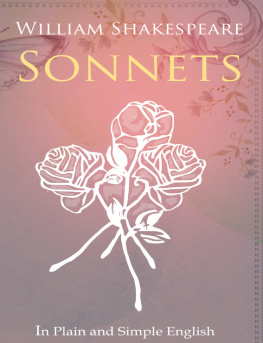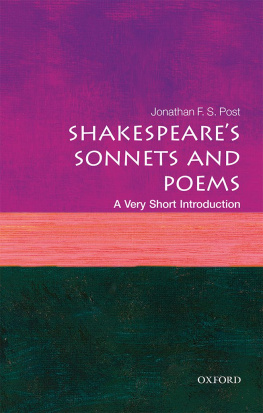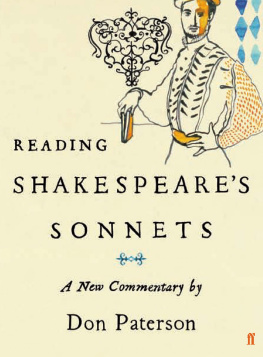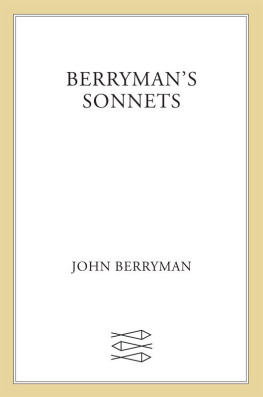
Table of Contents
LIBRARY OF CONGRESS CATALOGUING-IN-PUBLICATION DATA
Matz, Robert.
The world of Shakespeares sonnets : an introduction / Robert Matz.
p. cm.
Includes bibliographical references and index.
ISBN-13: 978-0-7864-3219-6
1. Shakespeare, William, 1564-1616. Sonnets. 2. Sonnets, EnglishHistory and criticism. I. Title.
PR2848.M33 2008
821'.3dc22 2007037638
British Library cataloguing data are available
2008 Robert Matz. All rights reserved
No part of this book may be reproduced or transmitted in any form or by any means, electronic or mechanical, including photocopying or recording, or by any information storage and retrieval system, without permission in writing from the publisher.
On the cover: Nicholas Hilliard, Henry Wriothesley, 3rd Earl of Southampton [15731624], 1594, miniature watercolour on vellum (The Fitzwilliam Museum); background 2008 Shutterstock
McFarland & Company, Inc., Publishers
Box 611, Jefferson, North Carolina 28640
www.mcfarlandpub.com
In Memory of
Karen Sara Erdman, 19642004
Acknowledgments
My thanks to many friends and colleagues who have generously read parts of this book and helped make it better: Scott Berg, Zofia Burr, Art Duval, Eric Eisner, Devon Hodges, Rosemary Jann, Deborah Kaplan, Gareth Lea, Cynthia Rogers, Sarah Schneewind, Alok Yadav, and Terry Zawacki. Special thanks to Denise Albanese, for taking on the whole thing. I have also benefited from the help of three terrific undergraduate research assistants: Linda Fauteux, Amaris Price and Alison Strubb. The staff of the Folger Shakespeare Library has likewise been of great help. George Mason University provided a semesters study leave to write this book, and the English Department at George Mason has been a congenial place to work. Many thanks to my parents, Lorraine and Joseph Matz, for their love and support, and to my sisters, Judith Matz and Ellen Frankel, for the same, as well as their good writing advice. My children, David and Rachel Matz, give me much joy. Teresa Michals guides me in my work and in most things else. No acknowledgment could answer all her gifts to me. This book is dedicated to the memory of Karen Sara Erdman, one of the sharpest and bravest thinkers I have ever known, and a fabulous teacher of English. Karen gave me early encouragement to write this book, and I always expected her to read a final draft of it. It would be a better book if she had, but I hope it nevertheless reflects something of her spirit, conversation and friendship.
Preface
How did sonnets get written in Shakespeares day? Heres one story. In the fall of 1599 Queen Elizabeth dined with Francis Bacon, the ambitious writer, courtier and royal counselor. Her visit to Bacons country retreat at Twickenham Park was unusual, and for Bacon probably nerve-racking. The times were tense. The queen was furious at the Earl of Essex, one of the most powerful men in England and, formerly, one of her favorite courtiers. He was under house arrest for what the queen saw as his failures and disobedience in the conduct of a military campaign in Ireland. Essex was also the patron of Bacon and his brother. The very estate where Bacon would entertain the queen was a gift from the earl. So, a nightmare dinner party: Bacon caught between Essex and Elizabeth, both of whom he depended on for his political advancement. What did Bacon do in this difficult situation? He wrote a sonnet. Its purpose, he later recalled, was to reconcile these warring giants. The sonnet, Bacon wrote, was a mere toy (or as we would say, trifle), but sometimes mens inclinations are opened more in a toy, than in a serious matter.
Two years later fortunes wheel had gone full turn. Bacon would write for Elizabeth about Essex again. But this time it was an essay, written at the queens request, published by her printer, and intended to justify Elizabeths execution of the earl, who was beheaded for treason after a desperate attempt to seize the throne. Bacon was well placed to write this justification of the queens actions, having also participated in the prosecution of his former patron. And he benefited from the service. Elizabeth granted Bacon 1,200, a huge sum at the time, raised from the fine of one of Essexs convicted co-conspirators.
Bacons sonnet and the fall of Essex seem worlds away from Shakespeares poetry of love. Yet they have much in common. Bacons sonnet has political purpose. Shakespeares sonnets, too, have social as well as literary and emotional significance. Bacons sonnet is written to Queen Elizabeth, but it concerns the Earl of Essex, whose supporters cultivated erotically charged friendships with the earl and with one another.
Likewise, most of Shakespeares sonnets are written to an aristocratic young man, whom the sonnets address as a friend, lover and patron. Bacon appeared to many to have betrayed Essex. So, too, the bond between Shakespeare and the aristocratic young man of the sonnets is haunted by betrayal on both sides.
Bacons sonnet has not survived, but his explanation of its specific subject and motive has. We have Shakespeares sonnets, but we lack a similarly clear explanation of their subjects and motiveseither from the sonnets themselves, or from Shakespeare or anyone else. For this reason I do not treat the sonnets as Shakespearean autobiography. But I also do not write as if the sonnets tell no story. Rather than revealing particular biographical events or persons, my goal in discovering that story is to identify the customs and beliefs that shaped the sonnets, Shakespeares life, and his world.
Many discussions of the sonnets emphasize their timeless expression of love. This book, by contrast, argues for the value of understanding the sonnets in their time. It explores Shakespeares brilliant, edgy sonnets through their roots in the equally brilliant, edgy culture of the English Renaissance. Each section shuttles between the poems and this cultural world. For example, I show what the interest in the sonnet at the Renaissance court has to do with the new fashion for the handkerchief there, while my discussion framing the sonnets homoeroticism ranges from love letters passed between King James and the Duke of Buckingham to what contemporary college students count (or dont count) as sex. Along the way readers will also discover:
The relationship between the sonnets and the tipsy excess of Renaissance rhetorical style
The connection of the sonnets to the revisionary history of sexuality that informed Lawrence v. Texas, the 2003 Supreme Court case that declared U.S. anti-sodomy laws unconstitutional
Seventeenth-century womens surprisingly modern responses to Renaissance antifeminist stereotypes
And why one eighteenth-century critic, reflecting the general opinion of the time, praised the sonnets exclusion from a collection of Shakespeares works (For where is the utility of propagating compositions which no one can endure to read?).
Readers interested in the sonnets as primarily formal works of art might turn to Helen Vendlers The Art of Shakespeares Sonnets. As Vendlers work shows, the sonnets contain many riches that formal literary analysis helps us to appreciate. While I also explore the literary qualities of the sonnets, I believe it important and illuminating to connect the sonnets to their world. This book has more in common with two recent introductions to the sonnets (both titled Shakespeares Sonnets, the one by Paul Edmondson and Stanley Wells, the other by Dympna Callaghan) but it emphasizes more the relationship between the sonnets and Renaissance culture than do these books. And though also introductory, it offers a more particular argument about the sonnets.
Next page








